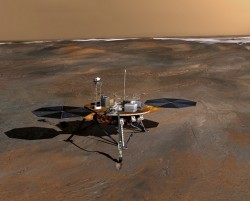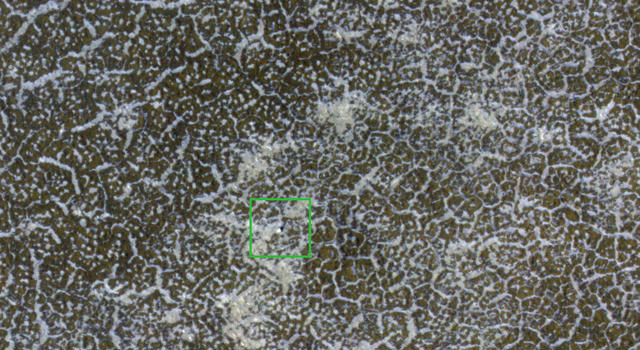Caption: The Phoenix Mars Lander, its backshell and its heatshield are visible within this enhanced-color image of the Phoenix landing site taken on Jan. 6, 2010 by the High Resolution Imaging Science Experiment (HiRISE) camera on NASA’s Mars Reconnaissance Orbiter. Image credit: NASA/JPL-Caltech/University of Arizona
Listen up, all you Phoenix lander fans! Beginning Jan. 18, the Mars Odyssey orbiter will start listening for any signs of life from Phoenix, which has been sitting silently on the frozen arctic region of Mars since its last communication in November 2008. The Phoenix team says hearing any radio transmission from the lander is high improbably, but possible. Never say never….

“We do not expect Phoenix to have survived, and therefore do not expect to hear from it. However, if Phoenix is transmitting, Odyssey will hear it,” said Chad Edwards, chief telecommunications engineer for the Mars Exploration Program at NASA’s Jet Propulsion Laboratory, Pasadena, Calif. “We will perform a sufficient number of Odyssey contact attempts that if we don’t detect a transmission from Phoenix, we can have a high degree of confidence that the lander is not active.”
Odyssey will pass over the Phoenix landing site approximately 10 times each day during three consecutive days of listening this month and two longer listening campaigns in February and March. The listening attempts will continue until after the sun is above the horizon for the full 24.7 hours of the Martian day at the lander’s high-latitude site. During the later attempts in February or March, Odyssey will transmit radio signals that could potentially be heard by Phoenix, as well as passively listening.

In the extremely unlikely case that Phoenix survived the winter, it is expected to follow instructions programmed on its computer. If systems still operate, once its solar panels generate enough electricity to establish a positive energy balance, the lander would periodically try to communicate with any available Mars relay orbiters in an attempt to reestablish contact with Earth. During each communications attempt, the lander would alternately use each of its two radios and each of its two antennas.
If Odyssey does hear from Phoenix, the orbiter will attempt to lock onto the signal and gain information about the lander’s status. The initial task would be to determine what capabilities Phoenix retains, information that NASA would consider in decisions about any further steps.
Phoenix landed in May, 2008 and worked for about five months before succumbing to the cold weather. Since then, Phoenix’s landing site has gone through autumn, winter and part of spring. The lander’s hardware was not designed to survive the temperature extremes and ice-coating load of an arctic Martian winter.
But who knows; our Mars spacecraft seemingly have a tendency to surprise us…
Source: JPL


Sure Phoenix rises from ashes, but can it re-life from the fiery breath of ices? Or more precisely, even if electronics are tough components, how will they fare when the boards and conductors was brittle and could snap?
I’ve no experience in freezing components. But if there is an activation energy for stresses, say from differential thermal contraction, it would be no worse than other failure modes. Components would fail randomly over time as usual. But wouldn’t it be typical if the radio goes before the CPU?
I will raise a few conjectures on this. The horizontally facing solar panels likely accumulated lots of snow from H_2O and CO_2. I don’t know how much, but I would not be surprised if the shear mass of snow broke the panels off and are now lying on the ground. If that happened Phoenix is dead. Another concern is with batteries. With automobiles serious cold can take the charge off the battery, leading to that frustrating problem of trying to start your car on a cold morning. I would imagine some stored energy or charge would be required for the craft to kick start itself. Also CO_2 might have condensed in the interior of the craft as extreme cold set in. I would imagine that does not do electronic components much good.
If Phoenix does rise from the ice and cold it would make the longevity of the Spirit and Opportunity rovers look positively humbrum.
LC
Phoenix Phone Home!
Bet it gets some kind of signal out. MPL aside, NASA’s luck on Mars has been remarkable.